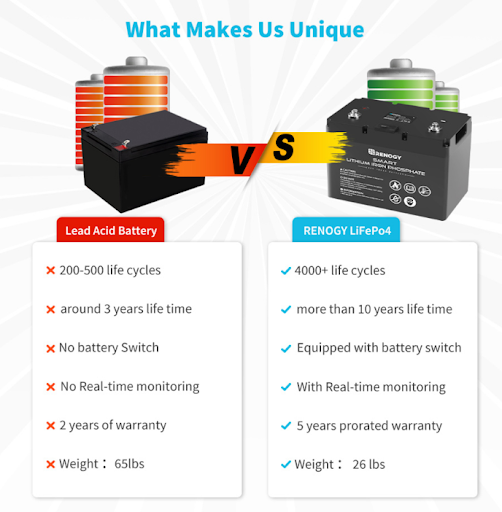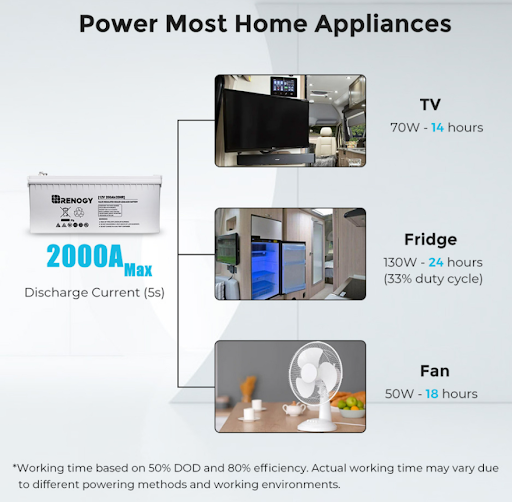To sign up for our daily email newsletter, CLICK HERE
To meet the technical requirements that determine maintenance, storage capacity, performance, useful life and the number of discharge cycles, we will find different types of solar batteries on the market. Below we will analyze the most suitable type of battery depending on the solar installation you want to carry out.
First of all, it is important to understand that conventional batteries, such as marine battery, have no similarity to solar batteries. This is because solar batteries have a much longer useful life, which will allow continuous deep discharges that will not affect the performance of the battery.

Solar batteries: basics
In photovoltaic solar installations, it is the solar batteries that allow the energy captured by the solar panels to be stored during production hours. If there is a surplus that is not used in consumption, the batteries save it to be able to use it at night, on cloudy days or in periods where the energy demand is greater.
A correct forecast of our needs is very important to choose the appropriate power in energy capture, so that the batteries can be recharged to their maximum frequently and take into account that the characteristics of the battery bank adjust to our pattern of use.
When choosing a 12 volt lithium battery, it is necessary that we understand some concepts that are closely related to each other, such as: voltage and amps, stored energy, depth and rate of discharge, useful life or expansion capacity.

Battery Basics
Voltage and amps: These denominations usually appear in solar batteries. Voltage is the number of cells or jars that the battery contains and amp-hours is a measure of energy that indicates the energy capacity of each jar.
Stored energy: to know the stored energy of a battery, its voltage must be multiplied by its capacity in amps and it is measured in watt-hours. For example, a 12V 100Ah battery stores a total energy of 1200 watt-hours. This measurement is very common to find in lithium batteries.
Depth and rate of discharge: Batteries can be for slow discharge applications, for traction, for emergency supply, etc. Depending on this, they have a discharge rate that usually ranges between 5 and 120 hours. This number is followed by a C and indicates how its capacity in amps to a final voltage has been obtained. For example:
A 12V and 100Ah battery in C10 and 1.8V per cell at 25º indicates that, after 10 hours of constant discharge, at an ambient temperature of 25º and a final voltage of 10.8V, we have obtained 100 amps of energy from that drums.
The same battery can offer more amps if it is discharged more lightly for a greater number of hours, it all depends on the type of use to which it is focused.
Useful life: it is the component of a solar installation that is most sensitive to use and also represents the largest investment in a photovoltaic kit. Its useful life is measured in life cycles, understanding a cycle as a process of loading and unloading. This is represented in a curve in the battery’s technical data sheets and tells us how many estimated life cycles we will have for different depths of discharge.
What is common in lead batteries is to find that, for a 50% depth of discharge, we will have more or less half the cycles than if we usually discharge only 30% of the battery’s capacity. It literally means doubling the useful life of the batteries. In lithium batteries it does not happen so drastically, offering more life cycles and with less sensitivity if the discharge is at 30 or 80%.
Expandability: A lithium battery is easily expandable since there is communication and balancing between the different modules that make it up. In a lead-acid battery, the wear and tear caused by joining accumulators in parallel means reducing its life cycles and total capacity, since the battery with the worst performance hampers the operation of the set.
Types of solar batteries
The most recommended and economical model to use in low and medium power installations where simple electrical devices without motors are used, are the monoblock solar batteries. We are talking about devices such as light bulbs, microwaves, television… In case you want to use batteries in more complex devices with a motor, this model will not be recommended since the high starting peaks caused by these devices are not recommended. for this type of battery. We refer to equipment such as a water pump, a drill, a washing machine… If we use the monoblock solar battery with this type of device, its average life will drop from 4-5 years, which usually lasts, to only one year. That is why our recommendation is not to use it in these cases. The maintenance of monoblock batteries is periodic, more or less every year and a half since they are open acid.
AGM batteries and GEL batteries are sealed and are made up of a gelled electrolyte that makes them have better performance and do not require maintenance, they are also manufactured in monoblock format. These batteries are capable of withstanding high starting peaks of any appliance without problems, so they are perfect for using any type of electrical device.
In those large or medium-sized installations that need batteries with a longer life than GEL or AGM batteries, those of the 12v lithium battery is used, since they have great resistance to continuous charge-discharge cycles and have an approximate duration of 20 years. This model will need refill maintenance every two years and be located in a ventilated place as it is an open battery model.

The GEL battery has a gelled electrolyte that transforms it into a completely sealed and maintenance-free stationary battery and also has the advantages of an stationary battery. This is the reason why they can be placed in a vertical or horizontal position. Its duration will be between 15 and 20 years.
Although this type of battery has a higher cost, it compensates for the investment made in its useful life. It is advisable to install stationary batteries in homes, farms or facilities for daily use, where the consumption to be made is previously known. In those medium-sized installations where expansions are planned for the future, it is more advisable to install GEL or AGM batteries.
Choose the type of battery
In this way, the use of one or another battery will depend on several factors:
– First, the size of the solar installation
– Of the electrical devices that are connected
– The purchasing power of each person.
It is vital to take into account the characteristics of each battery, since the use of a battery that is not suitable will cause new batteries to be installed in the short term and will affect the entire installation. It is important to take maximum care of the batteries, in order to extend their useful life, since they are the most expensive and sensitive part of the installation.